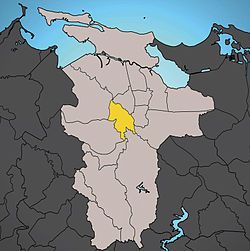El Cinco, San Juan, Puerto Rico
El Cinco | |
|---|---|
 Tren Urbano in El Cinco | |
 Location of El Cinco shown in yellow | |
| Coordinates: 18°23′29″N 66°03′45″W / 18.391275°N 66.062415°W[1] | |
| Commonwealth | |
| Municipality | |
| Area | |
• Total | 1.35 sq mi (3.5 km2) |
| • Land | 1.34 sq mi (3.5 km2) |
| • Water | 0.01 sq mi (0.03 km2) |
| Elevation | 66 ft (20 m) |
| Population (2020) | |
• Total | 5,610 |
| • Density | 4,200/sq mi (1,600/km2) |
| 2020 census | |
El Cinco is one of the 18 barrios of the municipality of San Juan, Puerto Rico and a former barrio of the dissolved municipality of Río Piedras. As of the 2020 United States Census, it had a population of 5,610 and a land area of 1.34 square miles (3.5 km2) resulting in a population density of 4,625.4/sq mi (1,785.9/km2).[3]
Geography
[edit]| Census | Pop. | Note | %± |
|---|---|---|---|
| 1950 | 2,330 | — | |
| 1960 | 6,535 | 180.5% | |
| 1970 | 8,132 | 24.4% | |
| 1980 | 8,043 | −1.1% | |
| 1990 | 8,426 | 4.8% | |
| 2000 | 7,149 | −15.2% | |
| 2010 | 6,198 | −13.3% | |
| 2020 | 5,610 | −9.5% | |
| U.S. Decennial Census 1900 (N/A)[4] 1910-1930[5] 1930-1950[6] 1980-2000[7] 2010[8] 2020[9] | |||
El Cinco is surrounded by seven barrios: Gobernador Piñero, Monacillo Urbano, Monacillo, Cupey, Sabana Llana Sur, Río Piedras (pueblo) and Hato Rey Sur.
Landmarks and historic sites
[edit]This barrio is home to numerous sites listed in the US National Register of Historic Places. The historic Río Piedras Aqueduct, also known as the San Juan Historic Aqueduct, is an old aqueduct and water filtration plant that dates from 1846. The site has been listed in the National Register of Historic Places since 2007.[10] Other historic sites located in El Cinco are the Río Piedras Bridge, shared with Hato Rey Sur and dating from 1853, the Rum Pilot Plant located University of Puerto Rico Experimental Agricultural Station,[11] and the San Juan Botanical Garden is located nearby too.
Transportation
[edit]The area is served by the Tren Urbano metro system with the elevated Cupey station located on the intersection of highways PR-1 and PR-176 in El Cinco. Despite the name of the station, it is not located in the barrio of Cupey, although it is indeed located nearby.
Gallery
[edit]-
Ruins of the historic aqueduct of Río Piedras
-
Historic Río Piedras Bridge
-
Cupey Station entrance
See also
[edit]References
[edit]- ^ a b "US Gazetteer 2019". US Census. US Government.
- ^ U.S. Geological Survey Geographic Names Information System: El Cinco barrio
- ^ "Census profile: El Cinco barrio, San Juan Municipio, PR". Census Reporter. Retrieved 2023-09-08.
- ^ "Report of the Census of Porto Rico 1899". War Department Office Director Census of Porto Rico. Archived from the original on July 16, 2017. Retrieved September 21, 2017.
- ^ "Table 3-Population of Municipalities: 1930 1920 and 1910" (PDF). United States Census Bureau. Archived (PDF) from the original on August 17, 2017. Retrieved September 21, 2017.
- ^ "Table 4-Area and Population of Municipalities Urban and Rural: 1930 to 1950" (PDF). United States Census Bureau. Archived (PDF) from the original on August 30, 2015. Retrieved September 21, 2014.
- ^ "Table 2 Population and Housing Units: 1960 to 2000" (PDF). United States Census Bureau. Archived (PDF) from the original on July 24, 2017. Retrieved September 21, 2017.
- ^ Puerto Rico: 2010 Population and Housing Unit Counts.pdf (PDF). U.S. Dept. of Commerce Economics and Statistics Administration U.S. Census Bureau. 2010. Archived (PDF) from the original on 2017-02-20. Retrieved 2019-08-02.
- ^ "Puerto Rico Population Declined 11.8% from 2010 to 2020". U.S. Dept. of Commerce Economics and Statistics Administration U.S. Census Bureau. 2020.
- ^ "Antiguo Acueducto del Río Piedras | National Trust for Historic Preservation". savingplaces.org. Archived from the original on 2022-01-21. Retrieved 2021-10-14.
- ^ "National Register of Historic Places listings in San Juan, Puerto Rico", Wikipedia, 2021-05-23, retrieved 2021-10-14




